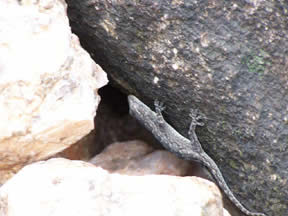-Mahavir Nimavat,
11 th Science,
St.Xavier’s High School,
Gandhinagar.
Last month, a nature education camp was organized by the Gandhinagar unit of “Youth Hostels of India” atRatan Mahal Wild Life Sanctuary on 13, 14, and 15 th of August. Ratanmahal is situated in Dahod district. Previously
the jungle was owned by the Maharaja of Devgadh Baria. It was declared a sanctuary in 1982. Ratanmahal harbors maximum population of Sloth Bears in the state. More over, it possesses a rich treasure of flora and fauna. Leopards, Hyena, Chausinga and Porcupine
are the main animals. Cobra, Krait, Russell’s viper, Saw scale Viper and Bamboo Pit Viper are also found there. The pristine beauty the forest in this small tract with rugged topography gives a feel of a hill station.
 The sanctuary area is small – only 65.55 sq.kms. However, the diversity is enormous. Some patches are lush green throughout the year. In addition, the beauty of the forests after few inches of rain, glows enchantingly.
The sanctuary area is small – only 65.55 sq.kms. However, the diversity is enormous. Some patches are lush green throughout the year. In addition, the beauty of the forests after few inches of rain, glows enchantingly.
A group of 60 students participated in the camp. The journey started on the noon of the 13 th of august. After covering distance of 280 kms by a luxury coach, we reached there at 6:30 pm. Accommodation was arranged at an Ashram Shala
at Kanjeta, a village neighboring the sanctuary. Ashram Shala is a residential school for tribal kids.
On the first evening, there was a small talk about nature conservation, jungle discipline and the details about the sanctuary followed by a trek to river Paanam. Paanam is the main lifeline of Dahod and Panchmahal districts. Its catchment
area falls in Ratanmahal.
After dinner, there was a short trek. It was an exciting experience to walk through small trails under moon light. While on the trek we saw a Krait, the most venomous snake of our state. Suddenly some movement was noticed on an almond-tree;
there were two flying foxes fighting for food. All the participants saw them in torch light and were given information about the only flying mammal.
On the next day morning, after break fast the group started for Ratneshwar Mahadev. The trek is stiff and the distance is 9.5 kilometers from the base. But we all enjoyed the real beauty of jungle. Chirping of birds and the sweet sound
of air passing through bamboo canopies was mind blowing. At the foothills, dry deciduous teak forest is situated and at the periphery, there are beautiful dense bamboo bushes. As we climbed higher, we passed through a green patch of Arjun (sadad). Arjun is
very useful in cardiac disease. It is a peculiarity of this forest that most of the jungle is covered by pure patches of tree species like timroo, kada, arjun, jamun and aamla. 
Due to heavy rain in the last few days, streams were flowing; green bushes covered all the land. The diversity of flora of this area is very rich and so is the insect life. We reached the top at 12:30 pm. All the fatigue of a long and
stiff trek was gone with just a one glance of the breath taking beauty of the scene. We were at the top, surrounded by green hills. The atmosphere was cool and cloudy. We also saw a stonewall demarcating Gujarat from Madhya Pradesh. After taking lunch, there
were some talks about water preservation and information about sloth bears. Then the group started dismounting. During the trek back, we saw many birds like Crested Serpent Eagle, Paradise Fly catcher, Small Minivet, Fantailed Fly catcher, Indian Robin, Tree
Pie, Lesser Golden backed Woodpecker etc. While trekking back, the group collected four bags full of plastic and polythene waste.
In the evening, there was an interaction with local tribal children who are staying at Ashram Shala. After dinner there was a combined cultural program performed by camp participants and tribal children.
On the last day of the camp, we attended a flag-hoisting program at the ashram shala. Then went for a trek to ‘Rohat’ waterfall. The trek was very nice, stiff and zigzag passing thru a thick, green jungle. We climbed, climbed, and suddenly
saw a stunning scene. The water falls from a height of 200 feet in many streams. In addition, a straight valley on both sides of the fall is a rare scene here in Gujarat.
We went back to the base and had lunch. Took few photographs with the children and started our return journey towards Gandhinagar.
 It was an unforgettable experience for all the participants who saw various facets of nature and learnt many new things about nature and wild life. We are thankful to Chaitanya sir who taught us many good things, which are very important
for our life.
It was an unforgettable experience for all the participants who saw various facets of nature and learnt many new things about nature and wild life. We are thankful to Chaitanya sir who taught us many good things, which are very important
for our life.
( Photo: Wild Flower, Sun through Bamboos and Rock Gecko by Chaitanya)
( This report was sent by Chaitanya who is managing the Gandhinagar unit of “ Youth Hostels of India”, a Government of India initiative)